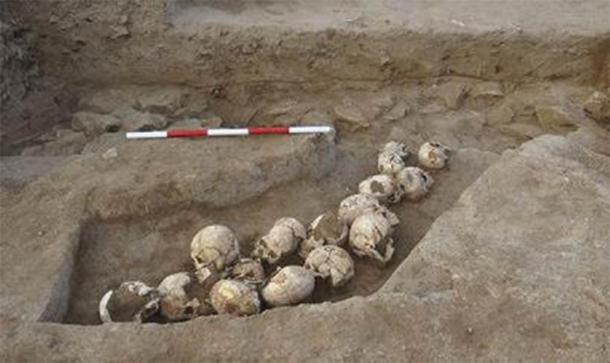Pits of Skulls Found in Shimao: China’s Neolithic City of Mystery
The villagers of China’s dusty Loess Plateau believed for decades that the crumbling rocks near their homes were from China’s Great Wall, which was very common along the area.
As large numbers of jade pieces shaped into disks, blades and scepters were found by locals and looters, suspicions grew as jade was only available at about 1000 miles away from the area and wasn’t even a feature of the Great Wall.
When a team of Chinese archaeologists came to investigate the rubbles, they started unearthing the area and found that the stones weren’t a part of the Great Wall but were the ruins of a magnificent fortress city.

The digging had revealed a 230 feet high pyramid surrounded by more than six miles of protective walls and an inner sanctum containing jade artifacts, painted murals, and gruesome evidence of human sacrifice.
Before the excavations were suspended earlier this year due to the coronavirus pandemic, the archaeologists had dug up 70 stunning stone sculptures which were figurines of monsters, serpents, and half-human beasts resembling Bronze Age iconography of China.

The site has been named Shimao (original name undetermined) and carbon dating of its parts date back to around 4,300 years ago i.e. 2,000 years before the oldest section of the Great Wall. As it seems, Shimao flourished for nearly half a millennium in that remote region, and then suddenly, it disappeared.

Shimao now is the largest known Neolithic settlement in China and none of the ancient Chinese texts mentions a city residing so far north of the “cradle of Chinese Civilization”. It had an expanse of 1000 acre and is larger than the Central Park of New York City. Its art and technology had influenced the northern regions and the future dynasties of China.
Along with other discoveries at prehistoric sites, Shimao is forcing historians to rethink the origin of the Chinese civilization.
According to the leader of the dig at Shimao, “Shimao is one of the most important archaeological discoveries of this century.”

Designed for danger, Shimao was built on a conflict zone i.e. a borderland dominated by warfare between farmers of the central plains and herdsmen of the northern steppe. To protect themselves from violent attacks, the Shimao people constructed their 20-tiered pyramid on the highest of the northern hills.
It’s visible from every part of the city and is half the height of the Great Pyramid at Giza in Egypt built around the same time. Its base, however, is four times larger and the Shimao elites resided at the topmost tier of the pyramid which had a 20-acre palatial complex with amenities.
The pyramid was surrounded by embryonic urban designs and inner and outer perimeter walls. More than 70 small satellite stone towns have also been discovered in the Shimao orbit.
The defense system of civilization is as fascinating as its infrastructure and huge fortifications. However, the most terrible discovery was from underneath the city’s eastern wall which had 80 human skulls clustered in six pits without the skeletons that represent traditions of human sacrifice in this astonishing prehistoric town.

